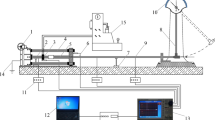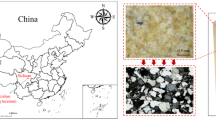Abstract
Asphaltene onset pressure (AOP) is a significant parameter for determining the flow assurance of live oils. The solid detection system (SDS) is one of the prevalent techniques used by service laboratories to evaluate the stability of asphaltenes under reservoir conditions. The determination of AOP based on this technique entails the interpretation of recorded data, making the accuracy of the result prone to error. Accordingly, this research aimed to provide a robust computational method for determining AOP by wavelet analysis of SDS data. Changes in the curvature of transmitted light (CTL) were considered a diagnostic criterion to detect AOP. To substantiate this hypothesis, CTL was first calculated at each pressure. The discrete wavelet transform was then applied to decompose the CTL curve and compute the CTL entropy \(\left( {E_{\text{CTL}} } \right)\) based on the decomposition results. Finally, a relation was established between AOP and the entropy variations of CTL \(\left( {\Delta E_{\text{CTL}} } \right)\), leading to the AOP determination model. This model indicated that the maximum value of \(\Delta E_{\text{CTL}}\) is at AOP. Put differently, the onset of asphaltene precipitation pressure corresponds to the highest variation in the CTL entropy. The results obtained from the AOP determination model in various reservoirs are consistent with the experimental findings.
















Similar content being viewed by others
Notes
1 psia = ~ 6895 Pa.
References
Abutaqiya, M. I., Sisco, C. J., & Vargas, F. M. (2019). A linear extrapolation of normalized cohesive energy (LENCE) for fast and accurate prediction of the asphaltene onset pressure. Fluid Phase Equilibria, 483, 52–69.
Addison, P. S. (2017). The illustrated wavelet transform handbook: Introductory theory and applications in science, engineering, medicine and finance (2nd ed.). New York: CRC Press.
Al-Aulaqi, T., Grattoni, C., Fisher, Q., Musina, Z., & Al-Hinai, S. (2011). Effect of temperature, oil asphaltene content, and water salinity on wettability alteration. In SPE/DGS Saudi Arabia section technical symposium and exhibition, 2011. Society of Petroleum Engineers.
Amin, J. S., Nikooee, E., Ghatee, M., Ayatollahi, S., Alamdari, A., & Sedghamiz, T. (2011). Investigating the effect of different asphaltene structures on surface topography and wettability alteration. Applied Surface Science, 257(20), 8341–8349.
Azamipour, V., Misaghian, N., & Assareh, M. (2019). Multi-level optimization of reservoir scheduling using multi-resolution wavelet-based up-scaled models. Natural Resources Research, 29, 2103–2125.
Berry, M. W., Mohamed, A. H., & Yap, B. W. (2015). Soft computing in data science. In: First international conference, SCDS, 2015 (p. 74). Berlin: Springer.
Chen, W., & Song, H. (2018). Automatic noise attenuation based on clustering and empirical wavelet transform. Journal of Applied Geophysics, 159, 649–665.
Dong, W., & Ding, H. (2016). Full frequency de-noising method based on wavelet decomposition and noise-type detection. Neurocomputing, 214, 902–909.
Esmaeili, S., & Maaref, S. (2018). Applying the Patel-Teja EoS with regular solution theory to predict the onset of asphaltene precipitation. Fluid Phase Equilibria, 473, 112–126.
Fakher, S., Ahdaya, M., Elturki, M., Imqam, A., & Elgahawy, Y. (2019) The effect of unconventional oil reservoirs’ nano pore size on the stability of asphaltene during carbon dioxide injection. In Carbon management technology conference, 2019. Carbon Management Technology Conference.
Gao, R. X., & Yan, R. (2010). Wavelets: Theory and applications for manufacturing. Berlin: Springer.
Ghadimi, M., Amani, M. J., Ghaedi, M., & Malayeri, M. R. (2019). Modeling of formation damage due to asphaltene deposition in near wellbore region using a cylindrical compositional simulator. Journal of Petroleum Science and Engineering, 173, 630–639.
Han, X., Huang, Z.-X., Chen, X.-D., Li, Q.-F., Xu, K.-X., & Chen, D. (2017). On-line multi-component analysis of gases for mud logging industry using data driven Raman spectroscopy. Fuel, 207, 146–153.
Heidary, M. (2015). The use of kernel principal component analysis and discrete wavelet transform to determine the gas and oil interface. Journal of Geophysics and Engineering, 12(3), 386–399.
Heidary, M., & Javaherian, A. (2013). Wavelet analysis in determination of reservoir fluid contacts. Computers & Geosciences, 52, 60–67.
Heidary, M., Kazemzadeh, E., Moradzadeh, A., & Bagheri, A. M. (2019). Improved identification of pay zones in complex environments through wavelet analysis on nuclear magnetic resonance log data. Journal of Petroleum Science and Engineering, 172, 465–476.
Kadkhodaie, A., & Rezaee, R. (2017). Intelligent sequence stratigraphy through a wavelet-based decomposition of well log data. Journal of Natural Gas Science and Engineering, 40, 38–50.
Kalantari, F., & Farahbod, F. (2019). Mixing of crude oil with organic ZnO nano-particles from rice bran to improve physical properties of crude oil: A novel agent for enhanced oil recovery. Natural Resources Research, 28(3), 1183–1196.
Mahmoudvand, S., Shahsavani, B., Parsaei, R., & Malayeri, M. R. (2019). Prediction of asphaltene precipitation upon injection of various gases at near-wellbore conditions: A simulation study using PC-SAFT EoS. Oil & Gas Science and Technology-Revue d’IFP Energies nouvelles, 74, 63.
Mansourpoor, M., Azin, R., Osfouri, S., Izadpanah, A. A., & Saboori, R. (2019). Experimental investigation of rheological behavior and wax deposition of waxy oil-disulfide oil systems. Natural Resources Research, 28(4), 1609–1617.
Mehana, M., Abraham, J., & Fahes, M. (2019). The impact of asphaltene deposition on fluid flow in sandstone. Journal of Petroleum Science and Engineering, 174, 676–681.
Memon, A., Borman, C., Mohammadzadeh, O., Garcia, M., Tristancho, D. J. R., & Ratulowski, J. (2017). Systematic evaluation of asphaltene formation damage of black oil reservoir fluid from Lake Maracaibo, Venezuela. Fuel, 206, 258–275.
Mohammadzadeh, O., Taylor, S. D., Eskin, D., & Ratulowski, J. (2019). Experimental investigation of asphaltene-induced formation damage caused by pressure depletion of live reservoir fluids in porous media. SPE Journal. https://doi.org/10.2118/187053-PA.
Mortimer, R. G. (2013). Mathematics for physical chemistry (4th ed.). New York: Academic Press.
Nascimento, F. P., Souza, M. M., Costa, G. M., & Vieira de Melo, S. A. (2019). Modeling of the asphaltene onset pressure from few experimental data: A comparative evaluation of the Hirschberg method and the cubic-plus-association equation of state. Energy & Fuels, 33(5), 3733–3742.
Naseer, M. T., & Asim, S. (2017). Detection of cretaceous incised-valley shale for resource play, Miano gas field, SW Pakistan: Spectral decomposition using continuous wavelet transform. Journal of Asian Earth Sciences, 147, 358–377.
Pedersen, K. S., Christensen, P. L., & Shaikh, J. A. (2014). Phase behavior of petroleum reservoir fluids (2nd ed.). New York: CRC Press.
Qian, K., Yang, S., Dou, H.-E., Pang, J., & Huang, Y. (2019). Formation damage due to asphaltene precipitation during CO2 flooding processes with NMR technique. Oil & Gas Science and Technology-Revue d’IFP Energies nouvelles, 74, 11.
Stoer, J., & Bulirsch, R. (2013). Introduction to numerical analysis (Vol. 12). Berlin: Springer.
Struchkov, I., & Rogachev, M. (2017). Risk of wax precipitation in oil well. Natural Resources Research, 26(1), 67–73.
Taqvi, S. T., Almansoori, A., & Bassioni, G. (2016). Understanding the role of asphaltene in wettability alteration using ζ potential measurements. Energy & Fuels, 30(3), 1927–1932.
Uetani, T. (2014). Wettability alteration by asphaltene deposition: A field example. In Abu Dhabi international petroleum exhibition and conference, 2014. Society of Petroleum Engineers.
Wang, F., & Zheng, S. (2016). Diagnostic of changes in reservoir properties from long-term transient pressure data with wavelet transform. Journal of Petroleum Science and Engineering, 146, 921–931.
Wang, P., Zhou, Y., Lv, Y., & Xiang, Y. (2020). Using wavelet filtering to perform seismometer azimuth calculation and data correction. Computers & Geosciences, 139, 104447. https://doi.org/10.1016/j.cageo.2020.104447.
Xie, F., Xiao, C., Liu, R., & Zhang, L. (2017). Multi-threshold de-noising of electrical imaging logging data based on the wavelet packet transform. Journal of Geophysics and Engineering, 14(4), 900–908.
Xu, H., Sun, S. Z., Gui, Z., & Luo, S. (2015). Detection of sub-seismic fault footprint from signal-to-noise ratio based on wavelet modulus maximum in the tight reservoir. Journal of Applied Geophysics, 114, 259–262.
Zhang, F.-D., Liu, J., Lin, J., & Wang, Z.-H. (2019). Detection of oil yield from oil shale based on near-infrared spectroscopy combined with wavelet transform and least squares support vector machines. Infrared Physics & Technology, 97, 224–228.
Zhang, Q., Zhang, F., Liu, J., Wang, X., Chen, Q., Zhao, L., et al. (2018). A method for identifying the thin layer using the wavelet transform of density logging data. Journal of Petroleum Science and Engineering, 160, 433–441.
Acknowledgments
The authors gratefully acknowledge the support of the Research Institute of Petroleum Industry (RIPI) for this project.
Author information
Authors and Affiliations
Corresponding author
Rights and permissions
About this article
Cite this article
Heidary, M., Fouladi Hossein Abad, K. A Wavelet-Based Model for Determining Asphaltene Onset Pressure. Nat Resour Res 30, 741–752 (2021). https://doi.org/10.1007/s11053-020-09753-w
Received:
Accepted:
Published:
Issue Date:
DOI: https://doi.org/10.1007/s11053-020-09753-w




